Estimation of unloading relaxation depth of Baihetan Arch Dam foundation using long-short term memory network
Ming-jie He ,Ho Li ,Jin-rong Xu ,Hun-ling Wng ,Wei-y Xu ,*,Shi-zhung Chen
a Powerchina Huadong Engineering Corporation Limited,Hangzhou 311122,China
b Research Institute of Geotechnical Engineering,Hohai University,Nanjing 210098,China
c Key Laboratory of Ministry of Education for Geomechanics and Embankment Engineering,Hohai University,Nanjing 210098,China
Abstract The unloading relaxation caused by excavation for construction of high arch dams is an important factor influencing the foundation’s integrity and strength.To evaluate the degree of unloading relaxation,the long-short term memory(LSTM)network was used to estimate the depth of unloading relaxation zones on the left bank foundation of the Baihetan Arch Dam.Principal component analysis indicates that rock characteristics,the structural plane,the protection layer,lithology,and time are the main factors.The LSTMnetwork results demonstrate the unloading relaxation characteristics of the left bank,and the relationships with the factors were also analyzed.The structural plane has the most significant influence on the distribution of unloading relaxation zones.Compared with massive basalt,the columnar jointed basalt experiences a more significant unloading relaxation phenomenon with a clear time effect,with the average unloading relaxation period being 50 d.The protection layer can effectively reduce the unloading relaxation depth by approximately 20%.
Keywords:Columnar jointed basalt;Unloading relaxation;Long-short term memory(LSTM)network;Principal component analysis;Stability assessment;Baihetan Arch Dam
1.Introduction
The Baihetan Hydropower Station is located on lower reaches of the Jinsha River.The main rock mass at the dam foundation is columnar jointed basalt.The cross-section of columnar jointed basalt is characterized by a regular array of polygonal prisms or columns,and microcracks often develop in columns.The columnar jointed basalt of the Baihetan Hydropower Station is relatively broken,but the pieces are inlaid with one another.Some studies on the quality evaluation and triaxial mechanical properties of columnar jointed basalt rock mass have been conducted.In engineering construction,there are often excavation procedures.It has been reported that columnar jointed basalt rock mass shows significant excavation-induced unloading relaxation characteristics,and the mechanical properties of the rock mass deteriorate with the increase of the degree of relaxation,which has an important impact on engineering safety(Chen et al.,2014;Meng et al.,2019;Shan and Di,2013;Wei et al.,2011;Xu et al.,2011).
The unloading mechanics play an important role in the behavior of columnar jointed basalt under excavation conditions.The geometrical structure and failure modes of the columnar jointed basalt exposed at a dam foundation were presented in Jiang et al.(2019).On the other hand,Fei et al.(2018)studied the columnar jointed basalt in a specific test area,and analyzed the differences in the unloading relaxation characteristics of the III1and III2rock masses.It was found that the relaxation depth of the columnar jointed basalt was related to the crustal stress,rock mass quality,and gently dipping shear belts(Fan et al.,2018;Jiang et al.,2014;Lin et al.,2019).A uniform distribution survey line method was proposed to quantitatively describe the spatial structural features of the columnar jointed basalt exposed in limited outcrops(Cui et al.,2018).The unbalanced force is mainly located on the surface of slopes where faults are exposed(Zhong et al.,2019).Previous studies have mostly dealt with direct analysis of laboratory and field test results.
In recent years,machine learning has been widely used in various communities.Through knowledge of the existing data samples,the relationship between data and internal laws can be established in a specific way.Developed from the model of artificial neural networks(ANN),deep learning is a type of representation learning method based on data in machine learning.The concept was proposed by Hinton et al.(2006)based on ANN research.In geotechnical engineering,the machine learning method has been applied to a different purpose.Xu et al.(1999)developed a deformation analysis and prediction model for the high rock slope of the permanent ship lock of the Three Gorges Project using ANN.Zhang et al.(2018)established a deep-learning migration model of rock images based on Inception-v3.The extent of relaxation zones in tunnels excavated through columnar jointed basalt has been studied with the numerical discontinuous deformation analysis method(Hatzor et al.,2015).The processing and analysis of the acoustic wave test data of the Baihetan Hydropower Station are relatively simple,and long-term engineering data need to be studied using the deeplearning method.
The development of deep learning,especially with the appearance of long-short term memory(LSTM),offers a good solution for time series with long-term dependencies(Olah,2015).LSTM was first introduced by Hochreiter and Schmidhuber(1997)and subsequently refined and popularized by many researchers,such as Gers et al.(2000),Graves et al.(2005),Greff et al.(2017),and Kalchbrenner et al.(2015).These studies tremendously improved the performance of LSTM,and LSTM networks are now among the most efficient and widely used deep-learning networks.They have already been successfully applied to time-series analysis in prediction(Gers et al.,2002)and recognition(Ordonez and Roggen,2016)when traditional computational intelligence approaches fail.
In this study,based on five years of acoustic wave test data from observation holes in the left bank foundation of the Baihetan Arch Dam,an LSTM network was established to visualize of the unloading relaxation depth and to explore the influences of time,lithology,the structural plane,the protection layer,and other engineering factors on the unloading relaxation.This study is highly significant to understanding the unloading mechanical behavior of the columnar jointed basalt rock mass in the Baihetan Arch Dam foundation and to optimizing the excavation works.
2.Study area and data
2.1.Geological conditions
The Baihetan Hydropower Station is located downstream of the Jinsha River,at the border of Ningnan County of Sichuan Province and Qiaojia County of Yunnan Province.It is one of the cascade hydropower stations on the Jinsha River,with the Wudongde Hydropower Station upstream and the Xiluodu Hydropower Station 195 km away downstream.
The site is located to the east of the Zemuhe and Sikai-Jiaojihe fracture zones and to the north of the Xiaojiang fault zone.Although active fault zones exist in this region and the regional seismic activity is intense,no intense earthquake has been recorded within a 40-km range around the dam site,and the seismic risk to the Baihetan Hydropower Station results mainly from the influence of intense seismic activities of nearby seismic zones.
The Baihetan Arach Dam area is dominated by upper permian Emeishan formation basalts(P2β),as shown in Fig.1.Columnar jointed basalts(P2β33)develop at elevations of 540-730 m.Meanwhile,unfavorable geological structures,such as faults F17 and F16,often develop in this area,which have a significant influence on the stability and safety of the project.
Based on geological structure analysis and field tests,it has been found that the directions of initial in situ stress fields of both banks of the Baihetan Hydropower Station,which are influenced by factors such as fluvial erosion and slope unloading,deflect partly from NWW to NE(Jin et al.,2010).The faults at the dam site are small in scale,and there is no regional fault.Most are strike-slip faults,and a few are thrust faults.Geological structures are mainly composed of faults with thicknesses less than 1.0 m,fracture zones,and joints,mostly striking NW with a few striking NE and dipping at high angles.Fault zones have developed on both banks,5-20 cm in thickness and extending 20-260 m in length.

Fig.1.Top view and geological section of Baihetan Arch Dam foundation.
2.2.Acoustic wave test data
The acoustic wave test is widely used in rock engineering.In this study,a dual-receiver acoustic wave probe was put into the hole,and a transducer was used to transmit the acoustic wave.Two transducers received the acoustic wave,and the time difference between the two receiving transducers was monitored.
The distance between the two receiving transducers was divided by the time difference,and the acoustic wave velocity in the pore wall rock mass in this section could be calculated as follows:

where t1and t2are the times of the same excitation signal received by the two transducers,respectively;L is the distance between two receiving transducers,with L=0.2 m;and vpis the acoustic wave velocity.
Fig.2 shows the layout of 44 long-term observation holes drilled on the left bank foundation of the Baihetan Arch Dam with elevations of 600-834 m.The criteria for determining the relaxation depth of the rock mass in the excavation surface were as follows:if there was an obvious inflection point on the wave velocity curve,the corresponding depth value at the inflection point was taken as the relaxation depth(Shao et al.,2006);if there was no obvious inflection point on the wave velocity curve,the depth value corresponding to a wave velocity of 4 000 m/s was taken as the relaxation depth.The acoustic wave test data from 44 long-term observation holes were analyzed to obtain relatxation depths of the holes at different times.

Fig.2.Long-term observation hole distribution in left bank foundation(units:m).
3.Methodology
3.1.Long-short term memory network
The LSTM network is an effective method for solving the problem of gradient disappearance by introducing a gate control unit and linear connection(Meng et al.,2020).The gate control unit can selectively save and output the historical information,while the linear connection can transfer the output historical information unobstructed.Hence,the LSTM network can better capture the strong dependence between time-series data(Ertam,2019;Khokhlova et al.,2019;Michielli et al.,2019).
The structure of the LSTM network can be found in Greff et al.(2017).First,the input xtat time t and the output ht-1of the hidden layer at time t-1 are copied,with their randomly initialized weights.The forgetting gate,input gate,output gate,and new information after transformation are calculated as follows:

where ft,it,and Otare the forgetting gate,input gate,and output gate at time t,respectively;is the new information after transformation at time t;Wf,Wi,WO,and WCare the parameter matrices from the input layer to the hidden layer for the forgetting gate,input gate,output gate,and new information,respectively;Uf,Ui,UO,and UCare the self-cycling parameter matrices from the hidden layer to the hidden layer for the forgetting gate,input gate,output gate,and new information,respectively;bf,bi,bO,and bCare the offset parameter matrices for the forgetting gate,input gate,output gate,and new information,respectively;andσis the sigmoid function,which means that the outputs of the three gates are in the range of 0-1.
The forgetting gate ftand the input gate itare then used to control how much historical information Ct-1at time t-1 is forgotten and how much new information~Ctis saved,to update the internal memory cell state,and Ctat time t is obtained as follows:

The output gate Otis used to control how much information from the internal memory unit is passed to the hidden layer,and the output htis obtained as follows:

3.2.Principle component analysis(PCA)method
Given the complexity of the excavation-induced relaxation mechanism of the Baihetan Arch Dam foundation,the PCA method was adopted to analyze the influences of various factors on the relaxation depth.To represent the time effect,a logarithmic function of the cumulative time,between the current time and the time when monitoring began,was employed,and the cumulative load proportions of the structural plane,lithology,time,and protection layer were calculated,as shown in Table 1.The structural plane factor makes up the largest proportion of all factors,accounting for 28.9%.The second is the time effect factor,accounting for 26.1%.The influences of lithology and the protection layer are also large,accounting for 21.5%and 21.4%,respectively.Support has the least amount of influence on the relaxation depth,accounting for only 3.1%.Therefore,the structural plane,lithology,time,and protection layer have strong correlations with the relaxation depth,and are determined to be the main factors.

Table 1 Composite score of each factor.
4.Unloading relaxation depth model based on LSTM
4.1.LSTM network training and accuracy assessment
Based on the results of PCA analysis and position information,seven elements,including the geodetic coordinate X,geodetic coordinate Y,geodetic coordinate Z,time,lithology,structural plane distribution,and protective layer,were employed as the inputs of the LSTM model.The flowchart of the network is illustrated in Fig.3.
Fig.3 shows the structure and training process of the model.The trial-and-error method was used to obtain the parameters of the model after testing and adjusting.Based on the acoustic wave velocity measured at 44 long-term observation holes,65 238 groups of effective data were obtained from 2014 to 2019.Seventy percent of the data were used as a training set,15%were used as a test set,and 15%were used as a verification set.
After data preprocessing,the LSTMmodel of the unloading relaxation depth was obtained through training and verification testing.Fig.4(a)shows the model test accuracy for the hole LA4-3(at an elevation of 634.5 m).The mean squared error(MSE)of the LSTM model converges with the increase of training iterations.When the number of training iterations reaches 1 000,the qualified accuracy is guaranteed.In Fig.4(b),the LSTM model shows a strong performance for the prediction of the relaxation depth at the holes LA4-3 and LB3-1(at an elevation of 761.0 m),with MSEs of 6.7×10-6and 1.07×10-5,respectively.These results indicate that the LSTM model is highly accurate in predicting the relaxation depth and acoustic wave velocity.

Fig.3.Flowchart for LSTM-based deep-learning prediction.
4.2.Unloading relaxation characteristics of left bank foundation
As shown in Fig.5,a three-dimensional mesh model of the left bank foundation of the Baihetan Arch Dam was created using HyperMesh.Then,12 332 node coordinates on the foundation surface were extracted.This is a sufficient number to reflect the relaxation characteristics.
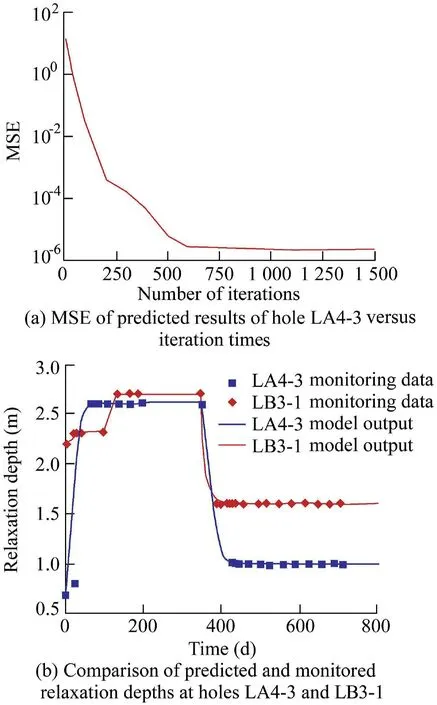
Fig.4.Accuracy verification of LSTM model.
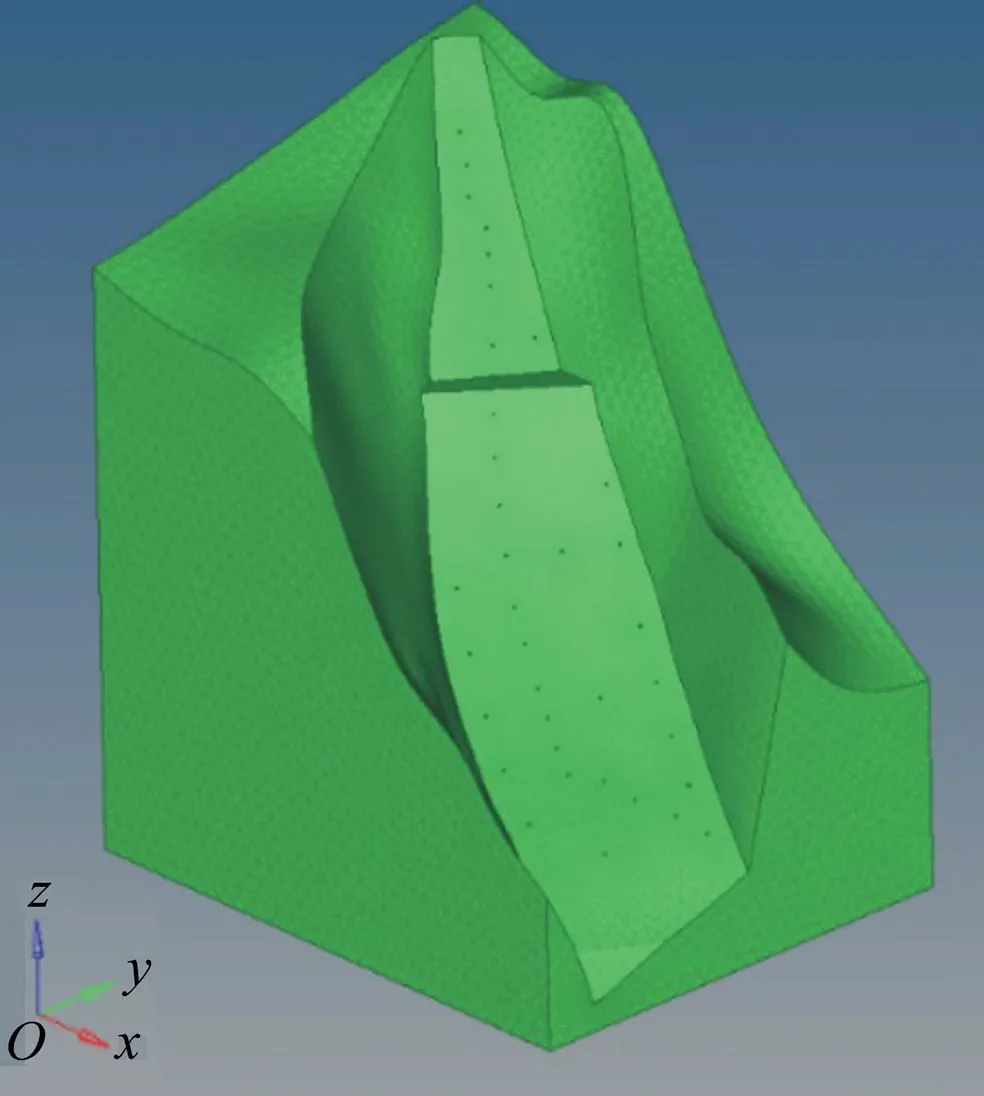
Fig.5.Three-dimensional model of left bank dam foundation.
To study the unloading relaxation characteristics,the input vector of 12 332 nodes on December 31,2016(after excavation)was fed into the LSTM model,and the distribution of unloading relaxation depth was acquired using spatial interpolation based on discrete points,as shown in Fig.6.After excavation,the relaxation depth of the dam foundation surface is distributed in a uniform bar shape,with a maximum relaxation depth of 2.630 m and a minimum relaxation depth of 0.370 m.Intensely deteriorated rock mass with a relaxation depth of more than 2.0 m is relatively scarce,and is mainly located on the right side at elevations of 800-830 m and on the left side at elevations of 630-660 m,accounting for approximately 17.26%of the dam foundation surface.There is only a small amount of slightly deteriorated rock mass with a relaxation depth less than 0.8 m,mainly in an oval area on the left side at elevations of 800-830 m and on the left side at elevations of 550-580 m.The maximum difference in the relaxation depth reaches 2.26 m,indicating that the unloading relaxation characteristics of rock mass in different areas of the same dam foundation surface are significantly different.The average relaxation depth is 1.57 m,and rock mass with the relaxation depth of 1.4-1.6 m is the most widely distributed,accounting for 46.21%of the left bank foundation surface.According to the Code for Hydropower Engineering Geological Investigation(GB 50287-2006)and project experience,a relaxation depth less then 1.5 m should not affect the project safety,a relaxation depth in the range of 1.5-3.0 m has a slight effect,and a relaxation depth greater than 3.0 m has a significant effect.Although the distribution of the excavationinduced unloading relaxation depth in the left bank foundation surface shows a certain variation,the average value is 1.57 m,meeting the requirements of project construction.
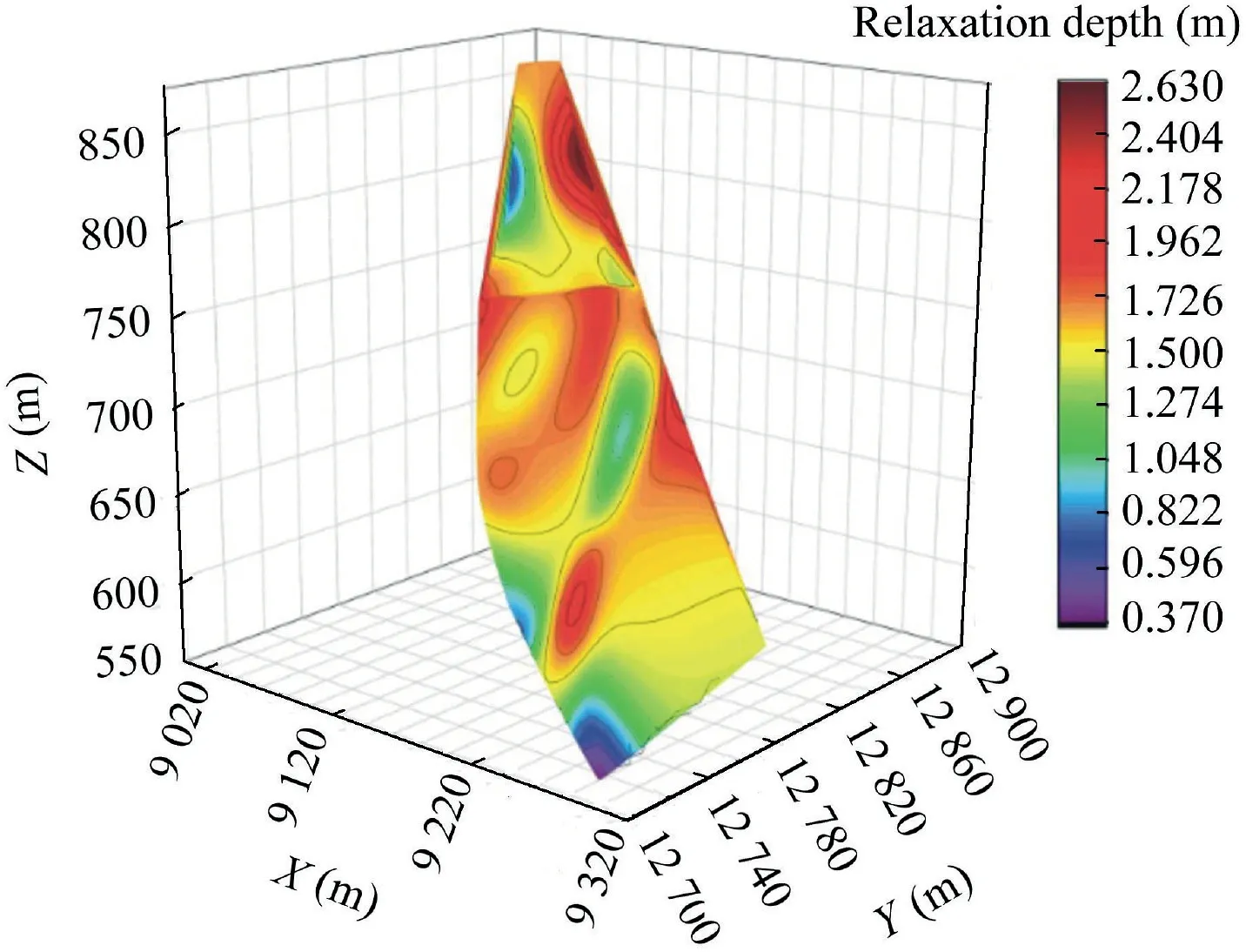
Fig.6.Relaxation depth distribution in left bank foundation.
5.Analysis of factors
5.1.Lithology
To study the relationship of the unloading relaxation depth with the lithology of the dam bedrock,different areas with different lithologies were selected,and their excavationinduced relaxation depths on January 1,2016 were obtained with the LSTM model,as shown in Fig.7.In the foundation surface with elevations above 660 m where P2β42-P2β33 massive basalts are distributed,areas with different unloading relaxation depths are interlaced with one another,and slightly deteriorated rock mass with a relaxation depth less than 0.8 m dominates.The average unloading relaxation depth is 1.09 m,with a maximum of 2.59 m and a minimum of 0.17 m.In the foundation surface with elevations of 630-660 m where columnar jointed basalts are distributed,areas with different unloading relaxation depths show block distribution.On the left side of the foundation,the rock mass intensely deteriorates with a relaxation depth of more than 2 m.On the right side,the rock mass moderately deteriorates with a relaxation depth of 0.71-1.45 m.The average unloading relaxation depth is 1.76 m,with a maximum of 2.71 m and a minimum of 0.71 m.Areas where columnar jointed basalts are distributed have stronger unloading relaxation effects and are within moderate and intense unloading relaxation zones.The interlacing of excavation-induced unloading relaxation depth is caused by the exposure of rock mass with different lithologies.
Statistics of the relaxation depth of rock mass with different lithologies are shown in Table 2.The excavation-induced unloading relaxation of cryptocrystalline basalt is relatively slight and the rock mass quality is high,while the columnar jointed basalt has intense unloading relaxation characteristics due to the existence of many joints,and the excavationinduced unloading relaxation depth is larger than that in other areas.

Table 2 Calculation results of relaxation characteristics for different lithologies in left bank foundation surface.
Fig.8 shows the distributions of lithology and excavationinduced relaxation depth in the left bank foundation at elevations of 750-770 m,and a strong correlation can also be observed.In the III1rock mass area,the relaxation depth is evenly distributed with little variation,and the value is kept at around 1.46 m.Meanwhile,the relaxation depth is also evenly distributed in the III2rock mass,with the value above 1.56 m.
Fig.9 shows the distributions of lithology and excavationinduced relaxation depth in the left bank foundation at elevations of 650-660 m.The average relaxation depth in this area is 1.37 m.The relaxation depths in the B2 and C2 areas are the largest,reaching approximately 1.7 m,followed by those in the A1 and A2 areas,with values of 1.5-1.7 m,and the relaxation depths in the B1 and C1 areas are the shallowest.The distribution and boundaries of rock type are similar to the contour lines of the relaxation depth,reflecting the correlation between rock type and unloading relaxation characteristics.However,the areas with the greatest relaxation depth are not completely consistent with the distribution of III2rock mass,indicating that the relaxation depth of the columnar jointed rock mass is also affected by other factors.
5.2.Structural plane
To analyze the relationship of the structural plane with excavation-induced unloading relaxation depth,the impact of structural planes on rock mass was first quantized and classified.Based on the in situ exploration of exposed rock mass and faults,the classification criterion of the rock mass was determined:the area within 1.5 m of the intersection of several exposed structural planes was classified as strongly affected;the area within 1.5 m of a single exposed structural plane was classified as moderately affected;the area within 1.5-3.0 m of a single exposed structural plane was classified as slightly affected;and the remaining areas were classified as unaffected.The classification of structural plane-affected areas is shown in Fig.10.
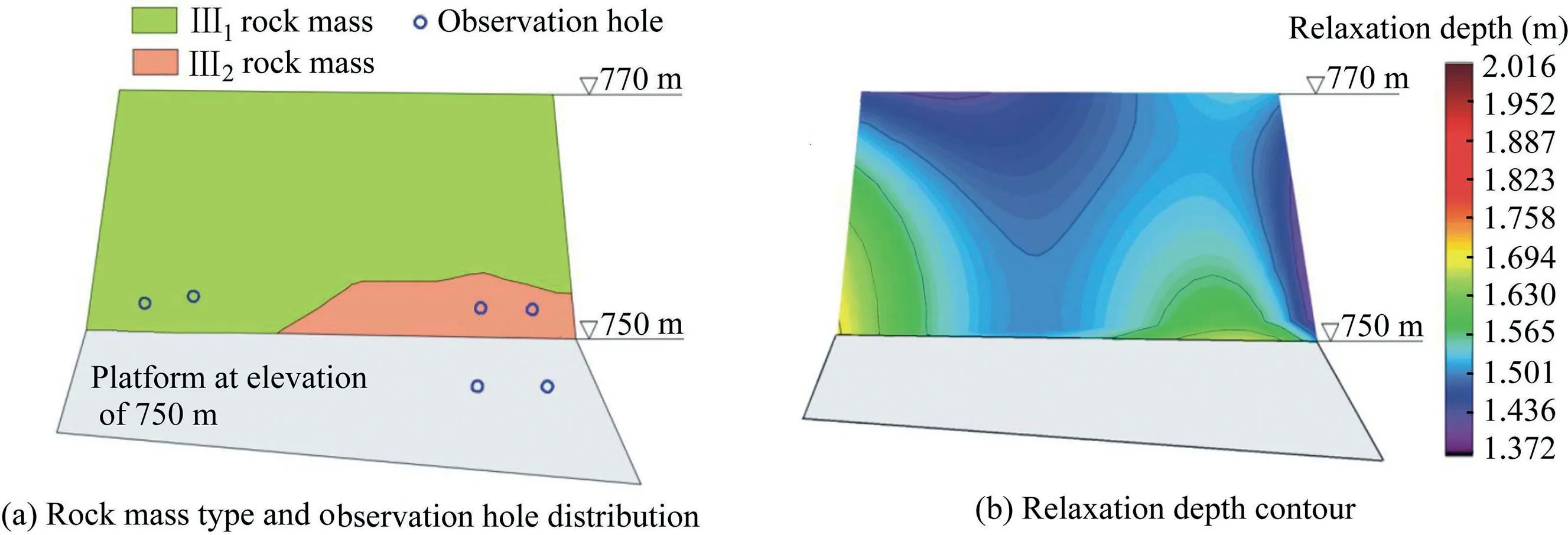
Fig.8.Rock mass type and relaxation depth distributions in left bank foundation at elevations of 750-770 m.
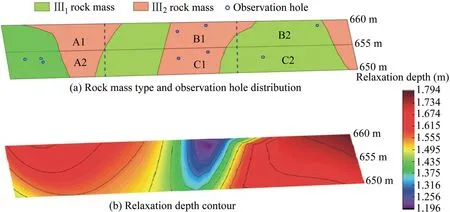
Fig.9.Rock mass type and relaxation depth distributions in left bank foundation at elevations of 650-660 m.
Comparison of Figs.7 and 8 shows a clear correlation between distributions of unloading relaxation depth and structural planes.Strong unloading relaxation zones are distributed in areas strongly affected by structural planes,including areas on the right side of the foundation with elevations above 800 m and the middle area of the foundation with elevations of 680-740 m.The distribution of moderate unloading relaxation zones is also basically consistent with that of areas moderately and slightly affected by structural planes,exhibiting almost the same extension shape and position.The relaxation depth of areas affected by structural planes with different degrees is shown in Table 3.In comparison with that of the non-affected area,the relaxation depths of the strongly,moderately,and weakly affected areas increase by 75.19%,53.49%,and 36.43%,respectively.Therefore,the structural plane has an indispensable influence on the unloading relaxation characteristics of rock mass in the dam foundation.As the rock mass gets closer to the structural plane(especially the intersection of structural planes),the unloading relaxation phenomenon becomes more intense.
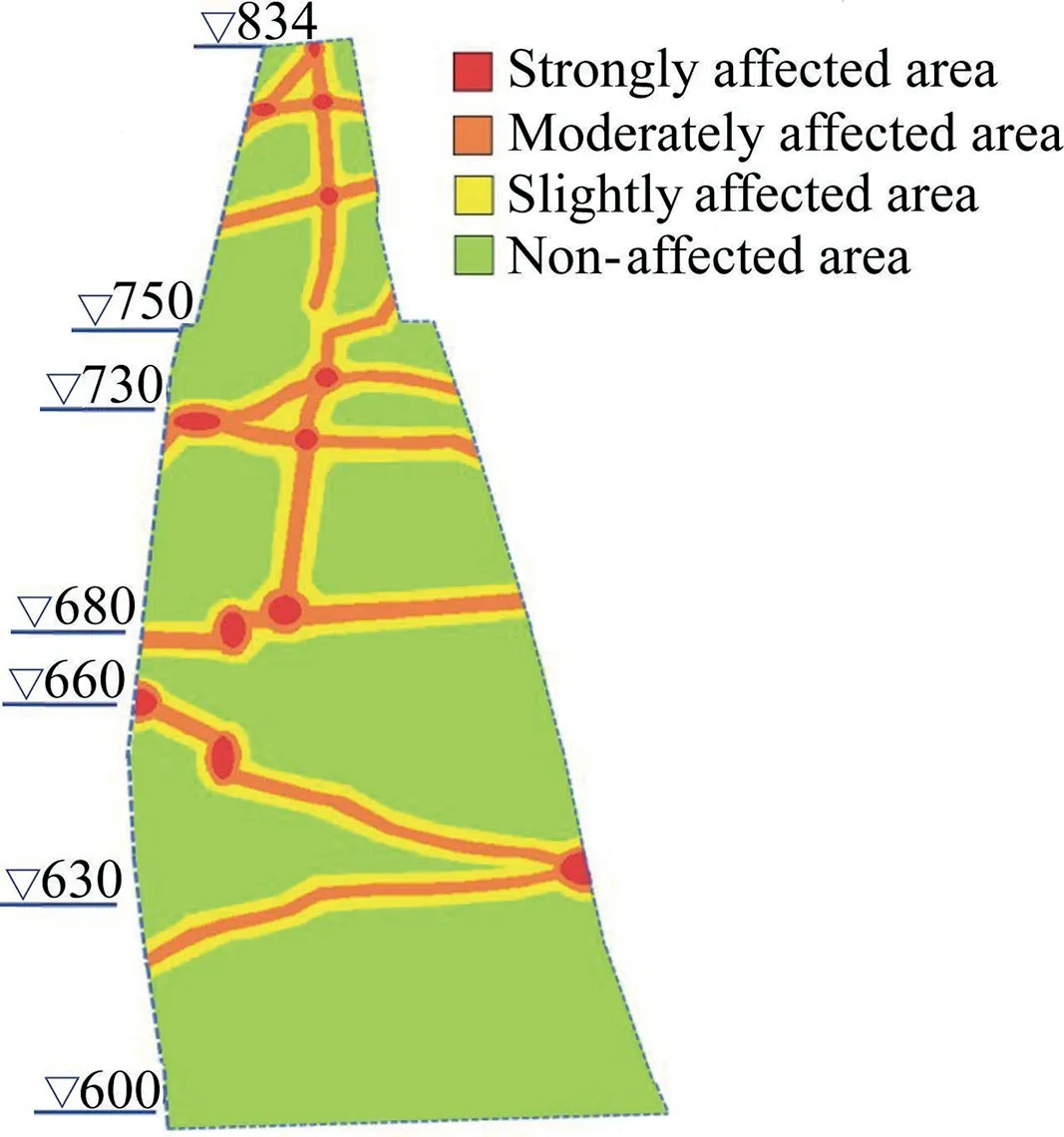
Fig.10.Schematic diagram of structural plane-affected areas on left bank(units:m).
5.3.Protection layer
The left bank foundation at elevations of 630-660 m is mainly composed of columnar jointed basalt,and considering its weak quality and unloading mechanical properties,a protection layer and prestressed cables were used during the excavation process in this area.To study the effectiveness of the protection layer,an input vector of node information in this area from February 1,2015(before excavation)to December 31,2016(after excavation)was imported into the LSTM model,and the distributions of unloading relaxation depth before and after the excavation were acquired,as shown in Fig.11.After excavation of the protection layer,the unloading relaxation depth becomes much shallower.Before excavation of the protection layer,the average relaxation depth of the protection layer surface is 1.92 m,with a maximum of 2.71 m and a minimum of 1.20 m.After excavation of the protection layer,the average relaxation depth of the foundation surface is 1.52 m,with a maximum of 1.92 m and a minimum of 1.05 m.The excavation of the protection layer reduced the average relaxation depth by 0.4 m,indicating that the use of a protection layer can relieve the unloading relaxation effect of the columnar jointed basalt.
The thicknesses of the protection layers in the foundation at elevations of 650-660 m and 630-650 m are 2 m and 5 m,respectively.The relaxation depths before and after excavation of the protection layer in the two test areas are listed in Table 4.In the foundation surface with a 2-m-thick protection layer,the relaxation depth after excavation of the protection layer is 18.84%lower,and the average wave velocity in the relaxation layer increases by 1.07%.In the foundation surface with a 5-m-thick protection layer,the relaxation depth after excavation of the protection layer is25.61%lower,and the average wave velocity in the relaxation layer increases by 1.41%.Therefore,a protection layer with a thickness of 5 m is better than a 2-m-thick protection layer.

Table 3 Calculation results of structural plane-affected areas at elevations of 600-834 m.

Fig.11.Relaxation depths before and after excavation of protection layer at elevations of 630-660 m obtained from LSTM model.
5.4.Time effect
Under the condition of initial crustal stress,cracks between the columns in the columnar jointed basalt rock mass are closed with high acoustic wave velocity.The excavation of slopes disturbs the microstructure of the rock mass,causing an unloading rebound,and then the cracks gradually open.The development of the cracks results in the time effect of unloading relaxation(Hao et al.,2015).The excavation of the protection layer at elevations of 630-660 m was completed in December 2015.Consolidation grouting started in July 2015,and excavation of the rest of protection layer has been conducted since February 2016.During this process,there was no disturbance other than excavation.Therefore,the distribution and development of the unloading relaxation depth after excavation of the protection layer were chosen for time effect analysis using the LSTM model.
Fig.12 shows the distributions of unloading relaxation depth at the protection layer surface at different times.The unloading relaxation develops rapidly with time and large changes can be found from 5 to 25 d and from 25 to 35 d:the distribution changes significantly and the relaxation depth increases by 59.33%and 77.38%,respectively.The distribution of the relaxation depth at 35 d is the same as that at 50 d,while the value of the relaxation depth stabilizes after 50 d,indicating that the unloading relaxation time effect period of columnar jointed basalt is approximately 50 d.
Based on the in situ monitoring data,changing rate curves of the relaxation depth in several long-term observation holes at different elevations are shown in Fig.13.Although the curves for different rocks are not the same,the overall development trend is the same:first growth,and then stabilization.According to the monitoring data,the convergence time is 43-60 d,with an average of 48.5 d,consistent with the LSTM model results listed above.
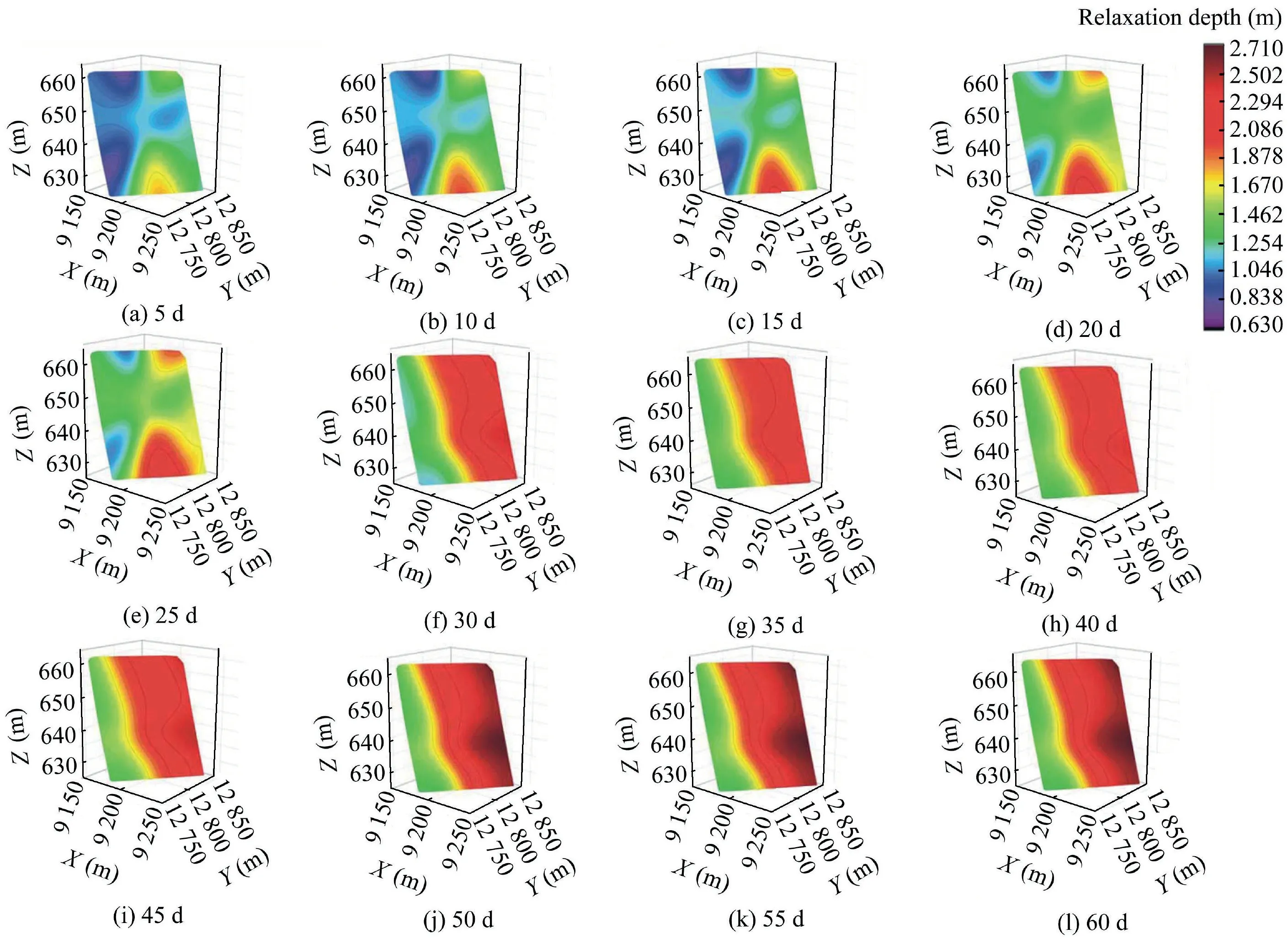
Fig.12.Time variation of relaxation depth of left bank dam foundation at elevations of 630-660 m from LSTM model.
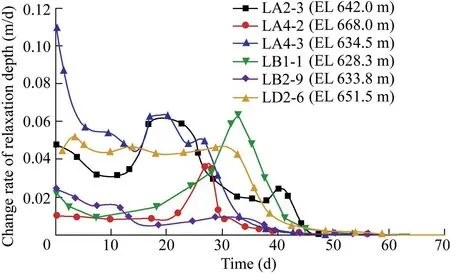
Fig.13.Change rate of relaxation depth in long-term observation holes of left bank dam foundation(EL means the elevation).
6.Conclusions
To evaluate the degree of unloading relaxation caused by excavation,an LSTM model was used to predict the depth of unloading relaxation zones in the left bank foundation of the Baihetan Arch Dam.After verification of the LSTM model accuracy,the unloading relaxation characteristics and their factors were analyzed.The conclusions are as follows:
(1)After excavation of the dam foundation,the exposure of faults and other structural planes severely affected the relaxation characteristics of surrounding rock mass.The distribution of unloading relaxation depth shows that,after the foundation excavation,the overall relaxation depth was about 1.57 m.PCA analysis indicates that the structural plane,protection layer,lithology,and time were the main factors of the excavation-induced unloading relaxation characteristics.
(2)The LSTMmodel could be developed and was found to be an efficient tool for the prediction of unloading relaxation depth of the Baihetan Arch Dam foundation.The results show that the protection layer could effectively relieve the unloading relaxation phenomenon.The relaxation depths of areas with 2-m and 5-m protection layers were 18.84%and 25.61%shallower than those of areas without protection layers,respectively,indicating that a 5-m protection layer would better control the relaxation depth.Excavation-induced unloading relaxation of the dam foundation rock mass may have a significant time effect,and the relaxation time effect period of the columnar jointed basalt was approximately 50 d.
(3)Compared with areas without the negative influence of structural planes,the relaxation depth of strongly,moderately,and slightly affected areas increased by 75.19%,53.49%,and 36.43%,respectively.As the rock mass got closer to the structural plane(especially the intersection of structural planes),the unloading relaxation phenomenon became more intense.Therefore,excavation construction should be optimized based on the distribution of structural planes and supporting measures should be strengthened.
Declaration of competing interest
The authors declare no conflicts of interest.
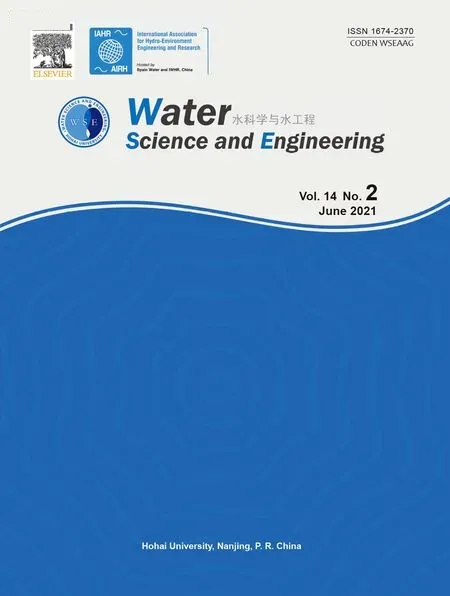 Water Science and Engineering2021年2期
Water Science and Engineering2021年2期
- Water Science and Engineering的其它文章
- Prediction of boundary shear stress distribution in straight open channels using velocity distribution
- Assessment of physicochemical properties of water and their seasonal variation in an urban river in Bangladesh
- Enhancement of removal efficiency of heavy metal ions by polyaniline deposition on electrospun polyacrylonitrile membranes
- Photodegradation of reactive blue 19 dye using magnetic nanophotocatalyst α-Fe2O3/WO3:A comparison study ofα-Fe2O3/WO3 and WO3/NaOH
- Preparation and characterization of Fe2O3/Bi2WO6 composite and photocatalytic degradation mechanism of microcystin-LR
- Influence of cascade reservoirs on spatiotemporal variations of hydrogeochemistry in Jinsha River
